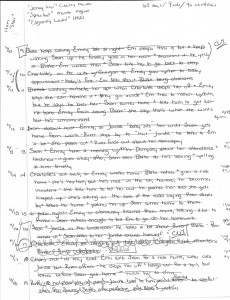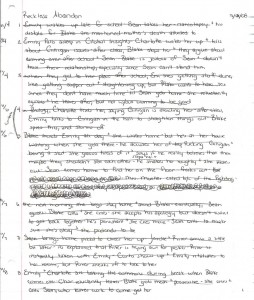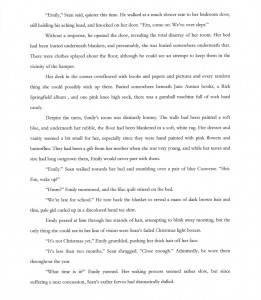The Mighty Outline
Questions I get from people a lot are “Do you outline?” and “How do you outline?” I was trying to think of ways to show people, but I didn’t know how to use books I published or planned to publish because I didn’t want to give away spoilers in the outline.
But I finally figured out a way to do it. I’m using an unfinished book I wrote called Reckless Abandon. It’s not very good, and it’s insanely long. I was a little over half-way through with it when I quit, and it was 114,000 words. (In comparison, Switched is just under 80,000 words). I also realized it was boring and nothing happened.
I did quite enjoy the writing of it, though, and it was a good exercise. According to my notes, I started writing it back in 2008, before I wrote My Blood Approves or any of the Trylle Trilogy. I’m scanned my outline and the notes I made, and I’m going to show you the first couple pages of the book, too, so you get an idea of how translates.
You’ll have to click on the pictures to see them at full size, because I didn’t want this blog to be ridiculously long.
Without further ado, here begins my notes for Reckless Abandon.
 |
|
| These are the very first notes I had on the book, with my general brainstorming ideas. I date everything, because I’m neurotic, and I apparently started this on 11/9/08. |
 |
| This is second page of the outline. Not too exciting. At the top, I’ve written down songs I was listening to while I was working on it. Why? I don’t know. It’s something I do, though. |
That all brings us to the book itself. I’m only posting the first two pages, because I think that gives you a general idea of how the first chapter outline turned into the book. I was going to post the entire first chapter, but it felt too long and boring, so I skipped it.
Obviously, outlines vary person to person.This is the way I outline, but there really is no wrong way or right way. I started outlining this way because it works for me, and this is pretty much the exact same way I’ve written the four My Blood Approves books, the Trylle Trilogy, Hollowland, and Virtue. I have an outline just like this one for Hollowmen and Wake.
Also, no need to point out issues with Reckless Abandon. It hasn’t been edited at all, other than a cursory read through I did before posting it now. I didn’t really want to go over in-depth, because I know the book sucks. It’s slow and boring, and I’m pretty sure that nothing happens. The love interest doesn’t even show up until the seventh chapter.
So… there. I hope this answers people’s questions and is helpful in some way.
Leave a Reply
[…] Here is an example of Amanda Hocking’s method of outlining the novels she writes. It’s not a hard-and-fast rule, but it seems to work for her, so you might want to try it. […]
حل ارتفاع فاتورة المياه
كشف تسرب المياه الكترونيا
تخزين اثاث
تهريب الحمامات والمطابخ
شركة عزل خزانات بالرياض
نقل اثاث
شركة تنظيف بالرياض
افضل شركات التنظيف في الرياض
شركة تنظيف شقق بالرياض
شركة مكافحة الحشرات بالرياض
شركة تنظيف منازل بالدمام
شركات تنظيف بالدمام
شركة تنظيف فلل بالرياض
تنظيف فلل
افضل شركة تنظيف فلل بالرياض
شركة تنظيف شقق بالرياض
شركة عزل اسطح بالرياض
شركة نقل اثاث بالرياض
Those of us with a long memory can compare Mr. Busch’s prose of today with that of years ago — and be delighted at how much more interesting and incisive it has become.
Thanks so much for taking the time to explain and share your process! The visuals are especially helpful, I think, in dispelling the idea that a book springs perfectly formed from the writer’s brain.
I also like that you outline on paper. Writing software can be wonderful, but also a huge timewaster, depending on how you use it, and paper is flexible, portable, and patient.
This reminds of of when I was writing my own work; I only made a few notes when mapping out my ideas but what I used the most was revision; I took one body of text and then I would reformat and redo some scenes. But your process is pretty neat; writing is a complex art that is sometimes underestimated as “complex” but there’s a lot of work involved. Thanks for putting up the outlines. I can learn a lot from them.
Thank you for taking the time to scan and share all that. It’s always interesting to see how another writing organizes her work.
I try to avoid writing anything of importance on paper anymore. With iPhone (or Android) it’s silly not to keep electronic notes. Though I used to use my email app on my old feature phone for same purpose. The key is to make sure you have a tool track that you can trust such as Evernote or Nozbe. Though a folder in your email works too.
In terms of specific outlines – I used to avoid them like the plague. But now I use them to sketch out idea. And I’m using Scrivener to write which makes it easy to do. But just keeping separate documents for this purpose would work as well.
Thanks for sharing this Amanda.
Best Regards,
Mark
i feel your love for patrick fugit. he’s amazing in wristcutters.
You …write that by hand? No freaking way. I hate writing ANYTHING out by hand. For one, I lose my train of thought far too easily, I can’t write as fast as I can type and since I type for a living I type fast. For another, I would lose my notes. Even if they were in a notebook, because that’s how I roll. 😉
 Amanda Hocking
Amanda Hocking







